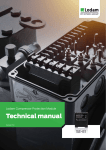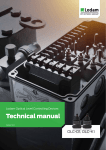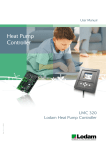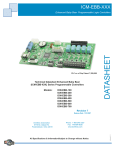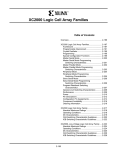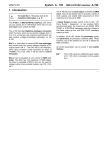Download SE-B1, -B2, -B3, -B4 Technical manual
Transcript
Lodam Compressor Protection Modules Technical manual Version 3.0 SE-B1, B2, B3, B4 Contents 1. Read this first. . . . . . . . . . . . . . . . . . . . . . . . . . . . . . . . . . . . . . . . . . . . . . . . . . . . . . . . . . . . . . . . . . . . . . . . . . . . . . . . . . . . . . . . . . . . . . . . . 4 1.1. Reading instructions. . . . . . . . . . . . . . . . . . . . . . . . . . . . . . . . . . . . . . . . . . . . . . . . . . . . . . . . . . . . . . . . . . . . . . . . . . 4 1.2. User manual. . . . . . . . . . . . . . . . . . . . . . . . . . . . . . . . . . . . . . . . . . . . . . . . . . . . . . . . . . . . . . . . . . . . . . . . . . . . . . . . . . . . . 4 1.3. Safety . . . . . . . . . . . . . . . . . . . . . . . . . . . . . . . . . . . . . . . . . . . . . . . . . . . . . . . . . . . . . . . . . . . . . . . . . . . . . . . . . . . . . . . . . . . . . . 4 2. General . . . . . . . . . . . . . . . . . . . . . . . . . . . . . . . . . . . . . . . . . . . . . . . . . . . . . . . . . . . . . . . . . . . . . . . . . . . . . . . . . . . . . . . . . . . . . . . . . . . . . . . . . 5 3. Definitions. . . . . . . . . . . . . . . . . . . . . . . . . . . . . . . . . . . . . . . . . . . . . . . . . . . . . . . . . . . . . . . . . . . . . . . . . . . . . . . . . . . . . . . . . . . . . . . . . . . . . 5 4. How to . . . . . . . . . . . . . . . . . . . . . . . . . . . . . . . . . . . . . . . . . . . . . . . . . . . . . . . . . . . . . . . . . . . . . . . . . . . . . . . . . . . . . . . . . . . . . . . . . . . . . . . . . . 6 5. Funtions. . . . . . . . . . . . . . . . . . . . . . . . . . . . . . . . . . . . . . . . . . . . . . . . . . . . . . . . . . . . . . . . . . . . . . . . . . . . . . . . . . . . . . . . . . . . . . . . . . . . . . . . 7 6. Examples of application use. . . . . . . . . . . . . . . . . . . . . . . . . . . . . . . . . . . . . . . . . . . . . . . . . . . . . . . . . . . . . . . . . . . . . . . . . . 8 6.1. Connections. . . . . . . . . . . . . . . . . . . . . . . . . . . . . . . . . . . . . . . . . . . . . . . . . . . . . . . . . . . . . . . . . . . . . . . . . . . . . . . . . . . . . 8 7. Technical data . . . . . . . . . . . . . . . . . . . . . . . . . . . . . . . . . . . . . . . . . . . . . . . . . . . . . . . . . . . . . . . . . . . . . . . . . . . . . . . . . . . . . . . . . . . . . . . 13 8. Drawings. . . . . . . . . . . . . . . . . . . . . . . . . . . . . . . . . . . . . . . . . . . . . . . . . . . . . . . . . . . . . . . . . . . . . . . . . . . . . . . . . . . . . . . . . . . . . . . . . . . . . . . 14 9. Standards . . . . . . . . . . . . . . . . . . . . . . . . . . . . . . . . . . . . . . . . . . . . . . . . . . . . . . . . . . . . . . . . . . . . . . . . . . . . . . . . . . . . . . . . . . . . . . . . . . . . . 15 10. Trouble shooting. . . . . . . . . . . . . . . . . . . . . . . . . . . . . . . . . . . . . . . . . . . . . . . . . . . . . . . . . . . . . . . . . . . . . . . . . . . . . . . . . . . . . . . . . . 15 11. Index. . . . . . . . . . . . . . . . . . . . . . . . . . . . . . . . . . . . . . . . . . . . . . . . . . . . . . . . . . . . . . . . . . . . . . . . . . . . . . . . . . . . . . . . . . . . . . . . . . . . . . . . . . . . . 16 12. Notes. . . . . . . . . . . . . . . . . . . . . . . . . . . . . . . . . . . . . . . . . . . . . . . . . . . . . . . . . . . . . . . . . . . . . . . . . . . . . . . . . . . . . . . . . . . . . . . . . . . . . . . . . . . 17 Page 2 Technical manual SE-B1, SE-B2, SE-B3, SE-B4 Page 3 1. Read this first The contents of this manual are subject to change without notice. Lodam electronics holds the copyright to this user’s manual. The user shall follow any instructions given in this user manual entirely and not only partly. Any non-following of this user manual result in exclusion of all warranties, guarantees, and liabilities. Copyright© 2014 by Lodam 1.1. Reading instructions The following symbols are used to draw the reader’s attentionto different warning levels. Important information. electronics a/s. All Rights Reserved. Danger!! General danger. Disposing of the parts of the controller: INFORMATION FOR USERS ON THE Danger of electrical current or voltage. CORRECT HANDLING OF WASTE ELECTRICAL AND ELECTRONIC EQUIPMENT (WEEE) In reference to European Union directive 2002/96/ EC issued on 27 January 2003 and the related national legislation, please note that: 1. WEEE cannot be disposed of as municipal waste and such waste must be collected and disposed of separately; 2. The public or private waste collection systems defined by local legislation must be used. In addition, the equip- 1.2. User manual Before installation the user should be thoroughly familiarized with this user manual, especially with purposes, installation and operation. Special care should be taken when installing and connecting external equipment (PTC sensor, high voltage etc) and handling the modules correctly according to protection against ESD. ment can be returned to the distributor at the end of its Installation of the SE-B1/SE-B2/SE-B3/SE-B4 working life when buying new must be performed by authorized personnel only. equipment; 3. The equipment may contain hazardous substances: All warranties are excluded in case installation is performed by unauthorized personnel or in case the the improper use or incorrect disposal of such may SE-B1/SE-B2/SE-B3/SE-B4 has not been correctly have negative effects on human health and on the installed. environment; 4. The symbol (crossed-out wheeled bin) shown on the product or on the packaging and on the instruction 1.3. Safety sheet indicates that the equipment has been intro- The SE-B1/SE-B2/SE-B3/SE-B4 is a protection duced onto the market after 13 August 2005 and that it device and not a safety component according to must be disposed of separately; the Machinery Directive and can not be used in 5. In the event of illegal disposal of electrical and elec- “medical” or “life support” equipment. tronic waste, the penalties are specified by local waste disposal legislation. Before plant commissioning the service technician shall ensure that personal safety requirements are met in conformity with the Machinery Directive on the basis of safety estimations. Electrical plant failures are to be immediately solved, even though no immediate danger exists; the SE-B1/SE-B2/SE-B3/SE-B4 and motor must be without power. Page 4 Technical manual SE-B1, SE-B2, SE-B3, SE-B4 2. General 3. Definitions The protection devices SE-B1, SE-B2, SE-B3 and SE-B4. Product range Hereafter SE-Bxare used for protection of the motor against overheating by monitoring motor temperature by means of PTC-sensors mounted in the motors windings. Further, other temperatures can be monitored by for example mounting PTC-sensors in the discharge outlet of a compressor, for monitoring the oil temperature or the Definitions HW Hardware/electronics NC Normally Closed (relay) NO Normally Open (relay) PTC Positive Temperature Coefficient (sensor element) SE-Bx A SE-B1, SE-B2, SE-B3 or SE-B4 compressor protection module temperature in vessels. In other areas where PTC-sensors are installed, they can also be monitored by a SE-Bx protection module. Due to their fast reaction time, good accuracy and built-in relay they can be a good solution instead of a separate controller. They can also be used as switch relays. A SE-Bx is default wired up for lockout in case of an overheat situation, but can also be used as a thermostat/ switch relay via the cool down period of the media surrounding the PTC-sensor. Page 5 4. How to Use the SE-Bx in lockout mode SE-B1/SE-B2/SE-B3 Use the SE-Bx in restart / hysteresis mode SE-B1/SE-B2/SE-B3 SE-B4 SE-B4 The wire jumper is default mounted in the two unnamed terminals – located between terminals N and 12. In this The wire jumper between the two unnamed terminals is mode a fault condition will need a manual reset to release removed. the relay. After an overheat condition, the relay is energized again as soon as the resistance is below the lower threshold level of 2.7 kOhm. There is no timer function in the SE-Bx. Page 6 Safety chain (NC) Open Technical manual SE-B1, SE-B2, SE-B3, SE-B4 Relay 14 11 Close relay 12 Open relay Closed 5. Funtions 14 11 If the restart blocking wire jumper is removed, the relay behaves like on the following diagram. 2,7kΩ The SE-Bx is a motor protection module. By monitoring the resistance in a PTC sensor, it will open its relay when the resistance of the PTC sensor increases above the limit Safety chain (NC) Open Closed 44081/82. The resistance of these PTC-sensors are not Relay Not Lockout and thereby cutting the control power as shown on the 12 14 11 12 (PTC resistance) 2,7kΩ detected by the protective device and the relay is released 14 11 Lockout open relay linear, but gives a steep rise in resistance when the threshold temperature of the PTC-sensor is reached. This is RPTC Lockout as shown below. The PTC-sensor could for example be according to DIN 4,5kΩ 12 (PTC resistance) 4,5kΩ RPTC In this mode, there is a hysterese from 2,7kOhm to 4,5 kOhm. When the resistance in the PTC-sensors increases diagram below. above 4,5 kOhm, the relay is released. The relay is released as long as the resistance is above 2,7 kOhm. When the Safety chain (NC) Open Relay 14 11 Close relay 12 resistance comes below 2,7 kOhm, the relay is energized. This hysteresis can be used for applications where the media where the PTC-sensors are mounted has such a Open relay large temperature inertia that this hysteresis is sufficient. Closed 14 11 12 (PTC resistance) 2,7kΩ 4,5kΩ RPTC Safety Since chain the increase in resistance is so steep, from 1 up to 9 (NC) Open Relay PTC-sensors canLockout be coupled in series without raising the 14 11 actual temperature threshold more than a few degrees 12 Lockout open relay Celsius. Not Lockout Default Closed there is a restart blocking wire jumper to prevent 14 11 a motor from being started too soon after having been 12 (PTC resistance) overheated. A manual reset must be done by RPTCremoving 2,7kΩ 4,5kΩ power from the module for minimum 5 seconds and then applying it again. Page 7 L1 L2 L3 N PE 1 F1 1 0 Page 8 M3 1W1 3 4 R7 Please see details regarding connection inside the terminal box R1-3 M1 Lockout wire jumper 1U1 Relay NC – Ok condition Unnamed 1V1 14 F13 9 Relay NO – Error condition 2 1 Relay common 12 01 S1 L 4A 7 H1 11 SE-B1 SE-B2 SE-B3 SE-B4 12 N F3 Neutral 11 6 N 5 Power supply 4 Description L K1 11 F2 3 Terminal Q1 2 14 B1 B2 F13 3 8 9 10 N L F6 P< F5 P> 3/3/3/12/ 16/17 18/19 K1 B1 K2T 18 F4 11 H2 K1 11 S T2 12 0/220 13 14 15 Y2 K1 11 16 Y3 B2 K1 11 17 11 K2T K1 11 18 6.1. Connections Option R8 K1 11 F12 4A 19 6. Examples of application use Compressor protection module with a direct starting compressor Method 1: L1 L2 L3 N PE 1 F1 L1 L2 L3 N PE 1 0 K1 11 F2 1 0 K1 11 F2 M3 1W1 1V1 3 4 R7 2 5 1 6 M1 M3 R1..6 1W1 1V1 1U1 3 F14 9 4 2W1 2V1 2U1 K2 14 5 R7 2 1 6 S2 01 S1 F3 S2 01 S1 F3 H1 11 SE-B1 SE-B2 SE-B3 SE-B4 12 N L 4A 7 Please see details regarding connection inside the terminal box R1..3 M1 1U1 F13 9 Q1 4 Please see details regarding connection inside the terminal box F13 9 Q1 2 F1 3 14 F4 13 3/3/3/10/ 15/16/ 18/19 B1 K2T 18 F6 P< F5 P> K3 9 11 11 Black Brown K1 11 10 Black Brown K1 11 10 K1 Orange 9 13 11 K3 Orange Red 9 K3 F14 5 14 B1 B2 F13 3 8 F4 Red B1 B2 F13 3 8 H1 11 SE-B1 SE-B2 SE-B3 SE-B4 12 N L 4A 7 max 0.5 sec 14 K1T 12 3/3/3/10/ 16 18/19 K1 B1 K2T 18 F6 P< F5 P> K3 9 11 H2 K3 9 13 12 K2 K1T 12 15 5/5/5/17 14 H2 K3 9 13 Y1 K1 11 K2 14 15 14 Y2 K1 11 16 15 17 Y3 B2 K2 14 Y2 K1 11 16 18 11 K2T K1 11 Y3 B2 17 Option 2 R8 K1 11 F12 4A 19 11 K2T K1 11 18 R8 K1 11 F12 4A 19 Method 2: Option 1 Technical manual SE-B1, SE-B2, SE-B3, SE-B4 Compressor protection module with a part winding compressor. Method 1: Page 9 Page 10 L1 L2 L3 N PE F1 1 0 K1 11 F2 1W1 1V1 1U1 3 R1-6 M3 M1 F14 9 4 3 4 2W1 2V1 2U1 K2 12 5 R7 6 Please see details regarding connection inside the terminal box F13 9 Q1 2 2 1 01 S1 F3 H1 11 SE-B1 SE-B2 SE-B3 SE-B4 12 N L 4A 7 14 B1 B2 F14 5 F13 3 8 9 10 N L F6 P< F5 P> 5/5/5/17 3/3/3/12/ 16/ 18/19 S T2 K2 K1T 13 H2 K1 11 12 K1 B1 K2T 18 F4 11 max 0.5 sec 12 K1T 0/220 13 Y1 K2 12 14 15 Y2 K1 11 16 Y3 B2 K2 12 17 Option 1 11 K2T K1 11 18 R8 K1 11 F12 4A 19 Method 2: Technical manual SE-B1, SE-B2, SE-B3, SE-B4 Oil flow monitoring using the SE-B1/SE-B2/SE-B3/SE-B4 module: 1 L1 L2 L3 N PE 2 3 4 5 6 7 8 9 10 11 12 13 14 01 F1 S1 1 0 Q1 F3 4A F2 F5 P> S2 F6 P< K4T 20 K5T 22 K1 9 K3 11 K2 9 11 L B1 B2 SE-B1 SE-B2 N F13 9 12 L2 + F8 14 F13 2 M1 M3 C1 R7 L3 12 F7 F9 )( 14 L1 11 1 2 3 K3T 19 7 8 9 K1T 13 K1 10 K2 9 K3 12 H2 K1 10 K1 10 K2 9 K3 12 H1 K2 5/5/5/10 12 K1 K3 2/2/2/11/12 13/16/17/19 18/20/25 4/4/4/16 24 9/13/18/25 K1T 2-3s 9 Page 11 Using the C1 electrolytic capacitor together with an additional time delay K3T will allow a temporary bridging of the monitoring function. Please note: The C1 electrolytic capacitor will be destroyed if mounted with wrong polarity! Measure the polarity off the two leads and connect the C1 according to the drawing. Legend for the schematic diagrams B1/B2 Control unit C1 Electrolytic capacitor F1 Main fuse F2 Compressor fuse F3 Control circuit fuse F4 Differential oil pressure switch F5 High pressure limiter F6 Low pressure limiter F7 Control circuit switch F8 Phase sequence control relay F9 Oil flow switch F12 Fuse for the crank case heater F13/F14 Thermal motor overload relay H1 Signal light “Over temperature” H2 Signal light “Oil pressure/flow fault” K1/K2/K3 Motor contactors K1T Time relay for part winding operation 2-3 s K2T Time relay Start-up delay K3T Time relay oil flow monitoring 10-20 s K4T Time relay pause time 300 s K5T Time relay oil level monitoring 120 s M1 Compressor Q1 Main switch R1..3 PTC sensors in motor windings R1..6 PTC sensors in part winding motor windings R7 PTC sensor in cylinder head/discharge gas temperature sensor R8 Crank case heater S1 Control switch Y1 Solenoid valve (Start unloading) Y2 Solenoid valve (Liquid line) Y3 Solenoid valve (Capacity control – Expansion valve) Page 12 Technical manual SE-B1, SE-B2, SE-B3, SE-B4 7. Technical data Technical specifications Description SE-B1 SE-B3 SE-B4 Supply voltage 230 VAC; +10% ~-15%, 50/60 Hz 2VA 24 VAC; +10% ~ -15%, 50/60 Hz 2VA 24 VDC; +20% ~ -20%, 50/60 Hz 1W 24 VDC version: no galvanic isolation SE-B2 115 - 230 VAC; +10% ~ -15% 50/60 Hz 2VA 230 VAC; +10% ~ -15%, 50/60 Hz, 2VA 24 VAC; +10% ~ -15%, 50/60 Hz, 2VA Permitted ambient temperature -30°C – +70°C -30°C – +60°C Relative humidity Max. 95% RH non-condensing Electronic circuit board is coated Air pressure 660 hPA to 1060 hPA PTC sensor cable length 120 mm Relay 24 VAC/VDC versions Switch voltage 24 VAC/VDC Continuous current max 10 mA (gold plated contacts). If current limit is exceeded, gold plating will be destroyed and current limit is then like the other versions listed below 350 mm All versions Switch voltage 250 VAC. Continuous current max 2.5A Switching capacity 300 VA, C300 (pilot type use according to UL508) Fuse required Max. 4A, fast-blow Enclosure class Terminals IP00 Field wiring markings Wire type (Cu only, 14 – 20 AWG) Use 60°C copper conductors only Terminal torque rating 6 lb-in.” / 0.7 Nm or equivalent Type of sensor PTC according to DIN 44081/44082 Number of sensors 1 to 9 in series Max total resistance, R25 total < 1.8 kΩ RTrig 4.5 kΩ ±5% RReset 2.7 kΩ ±5% Reset Interrupt supply power for min. 5 seconds Weight 150g; 24 VDC version: 90g Dimensions 68.3 mm (w) * 32.5 mm (d) * 50 mm (h) Mounting 35 mm snap-in or mounting with screws Housing material PA66 - GF UL file number E334756 Terminal wire range Cu 60°C only. 20-14 AWG / 0.5 mm2 - 2,0 mm2 Spade connection 6.3 mm * 0.8 mm / 1/4” Page 13 10,0 ±0,5 50,0 ±1 8. Drawings 29,2 1 ±1 55,5 32,5 1 68,3 ±0,5 Shown without wire 10 50 ±0,5 SE-B1/SE-B2/SE-B3 33 ±0,5 +1 68 0 55,5 ±0,5 3,5 4,5 2,5 7 SE-B4 Mounting is for standard rail 35 mm according to DIN EN 60715. Page 14 Technical manual SE-B1, SE-B2, SE-B3, SE-B4 9. Standards 10. Trouble shooting The product is manufactured according to the following Check if there is power to the unit according to standards. • RoHS 2002/95/EC specification. • Low voltage 206/95/EC • 61010-1 Safety requirement for electrical equipment for measurement and control If the power is ok: • Turn off the power for 5 seconds and see if the relay is energized after power on again. • EMC 2004/108/EC If not, turn off all the power to avoid risk of injury! • 61000-6-x Generic EMC • Unmount one of the cables to the PTC element in the motor The following standards have been used • EN 61010-1 Safety requirement for electrical equipment for measurement and control • EN 61000-6-1 Immunity for domicil, profession and light industry • If the measured resistance is above 4.5 kΩ ±5%, the temperature of the PTC-sensor is above the threshold limit and the relay has been released to protect the motor or installation. • If the measured resistance is more than 1 MΩ, there is a brokenconnection to the PTC-sensor and the relay will not be engaged. • EN 61000-6-3 Emission for domicil, profession and light industry • If the measured resistance is close to 0 Ω, there is a short circuit on the PTC-sensor cables and there is no overheat protection! • UL 508 UL file number E334756 • If power and resistance is ok, the protection module may be defect and needs replacement. Page 15 11. Index A S Application use 8 Schematic diagrams 12 D Definitions 5 Sensor type 13 Standards 15 Dimensions 13 T Direct starting compressor 8 Technical data 13 Drawings 14 Terminal torque rating 13 E Enclosure class 13 F Field wiring markings 13 Function 7 Fuse required 13 H Housing material 13 L Lockout mode 6 M Max total resistance 13 Mounting 13, 14 N Number of sensors 13 O Oil flow monitoring 11 Operation voltage 13 P Part winding compressor 9 Permitted ambient temperature 13 PTC sensor cable length 13 R Relay 13 Reset 13 Restart / hysteresis mode 6 Page 16 Trouble shooting 15 W Weight 13 Technical manual SE-B1, SE-B2, SE-B3, SE-B4 12. Notes Page 17 Innovative and energy saving climate control • • • • • • 16-01-2015 Contents are subject to change without notice. When it comes to climate control Lodam is one of the most experienced you can turn to. For more than four decades we have developed, produced and implemented electronic solutions dedicated to optimising applications like: Compressors Condensing units Heat pumps Air conditioning Refrigerated truck and trailer Reefer containers We know the importance of reliable, energy-efficient operation – and constantly push technologicalboundaries to bring you the most innovative and forward-thinking solutions. As part of the BITZER Group we are backed by one of the world’s leading players in the refrigeration and air conditioning industry. This alliance provides us with extensive network and application knowhow and allows us to stay at the forefront of climate control innovation. And to help ensure comfortable surroundings for humans and reliable protection of valuable goods anywhere in the world. For more information visit: Lodam electronics a/s Kærvej 77 6400 Sønderborg Denmark www.lodam.com Tel. +45 7342 3737 Fax +45 7342 3730 [email protected]


















